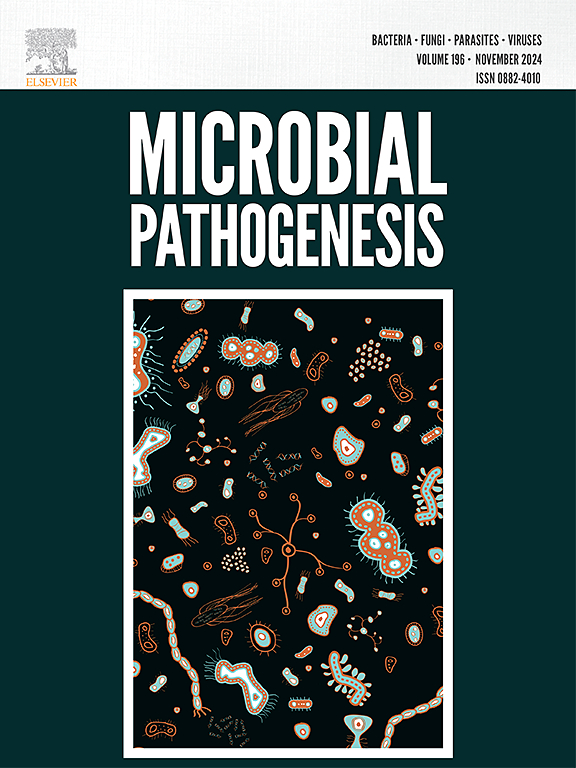Amoebicidal activity of Plantago lanceolata extract and expression of three genes in Acanthamoeba castellanii trophozoites
IF 3.5
3区 医学
Q3 IMMUNOLOGY
引用次数: 0
Abstract
This study investigated the therapeutic potential of an ethanolic leaf-stem extract from Turkish Plantago lanceolata against Acanthamoeba castellanii. The extract exhibited amoebicidal activity against A. castellanii trophozoites at varying concentrations (125, 62.5, 31.25, 15.625, 7.81, 3.9 and 1.95 mg/mL). The cytotoxicity of the extract in HeLa cells was investigated by 3-(4,5-dimethylthiazol-2-yl)-2,5-diphenyltetrazolium bromide (MTT) assay. The DNA protective potential of the extracts against DNA damage was investigated. The phytochemical constituents of the extract were identified and characterized using Gas Chromatography-Mass Spectrometry (GC-MS). RT-qPCR analysis quantified the transcriptional modulation of oxidative stress-responsive genes (SOD, CAT) and the pseudocyst formation marker CSII in A. castellanii trophozoites following exposure to P. lanceolata extract. The viability and number of Acanthamoeba trophozoites were evaluated through hemocytometer counting coupled with the Trypan Blue exclusion technique. IC50 values of A. castellanii trophozoites were 2.6, 4.2 and 14.45 mg/mL at the 72nd, 48th and 24th hours, respectively. MTT viability assays demonstrated dose-dependent cytotoxicity in HeLa cells following 72-h exposure to P. lanceolata extract (12.5, 6.25, 3.125, 1.562, 0.781, 0.391, 0.195 mg/mL), yielding an IC50 of 0.85 mg/mL. The extract exhibited protective effects against DNA damage induced by hydroxyl radicals at 15.625, 7.81 and 3.9 mg/mL concentrations. Furthermore, it was determined that the extract showed a strong inhibitory effect on CSII and almost as much effect on CAT and SOD genes as the specific inhibitors of CAT and SOD genes. The obtained data indicate that this extract may serve as a potential therapeutic agent for both the prevention and treatment of acanthamoebiasis.
车前草提取物的杀阿米巴活性及三种基因在棘阿米巴滋养体中的表达
本研究探讨了土耳其车前草叶茎乙醇提取物对棘阿米巴的治疗作用。不同浓度的提取物(125、62.5、31.25、15.625、7.81、3.9和1.95 mg/mL)对黄颡鱼滋养虫均有一定的杀阿米巴活性。采用3-(4,5-二甲基噻唑-2-基)-2,5-二苯基溴化四唑(MTT)法研究其对HeLa细胞的细胞毒性。研究了其对DNA损伤的保护作用。采用气相色谱-质谱联用技术(GC-MS)对提取液中的植物化学成分进行了鉴定和表征。RT-qPCR分析量化了杉木提取物暴露后,黄颡鱼滋养体氧化应激反应基因(SOD, CAT)和假囊肿形成标记物CSII的转录调节。通过血细胞计数结合台盼蓝排斥技术对棘阿米巴滋养体的活力和数量进行评价。在第72、48和24 h,食虫体的IC50值分别为2.6、4.2和14.45 mg/mL。MTT活性测定显示,暴露于杉木提取物(12.5、6.25、3.125、1.562、0.781、0.391、0.195 mg/mL) 72小时后,HeLa细胞的细胞毒性呈剂量依赖性,IC50为0.85 mg/mL。在15.625、7.81和3.9 mg/mL浓度下,提取物对羟基自由基诱导的DNA损伤具有保护作用。进一步确定了提取物对CSII具有较强的抑制作用,对CAT和SOD基因的抑制作用几乎与CAT和SOD基因的特异性抑制剂相同。所获得的数据表明,该提取物可作为预防和治疗棘阿米巴病的潜在治疗剂。
本文章由计算机程序翻译,如有差异,请以英文原文为准。
求助全文
约1分钟内获得全文
求助全文
来源期刊

Microbial pathogenesis
医学-免疫学
CiteScore
7.40
自引率
2.60%
发文量
472
审稿时长
56 days
期刊介绍:
Microbial Pathogenesis publishes original contributions and reviews about the molecular and cellular mechanisms of infectious diseases. It covers microbiology, host-pathogen interaction and immunology related to infectious agents, including bacteria, fungi, viruses and protozoa. It also accepts papers in the field of clinical microbiology, with the exception of case reports.
Research Areas Include:
-Pathogenesis
-Virulence factors
-Host susceptibility or resistance
-Immune mechanisms
-Identification, cloning and sequencing of relevant genes
-Genetic studies
-Viruses, prokaryotic organisms and protozoa
-Microbiota
-Systems biology related to infectious diseases
-Targets for vaccine design (pre-clinical studies)
 求助内容:
求助内容: 应助结果提醒方式:
应助结果提醒方式:


